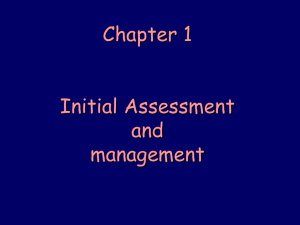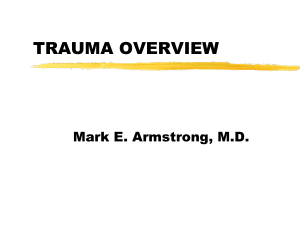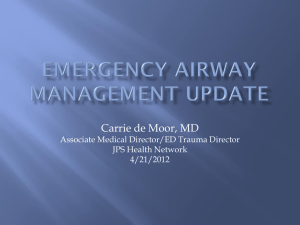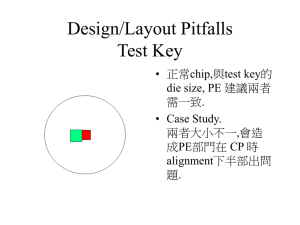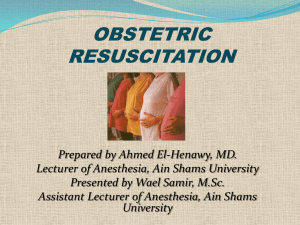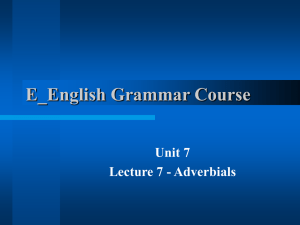Lecture Title - Specialists Without Borders
advertisement
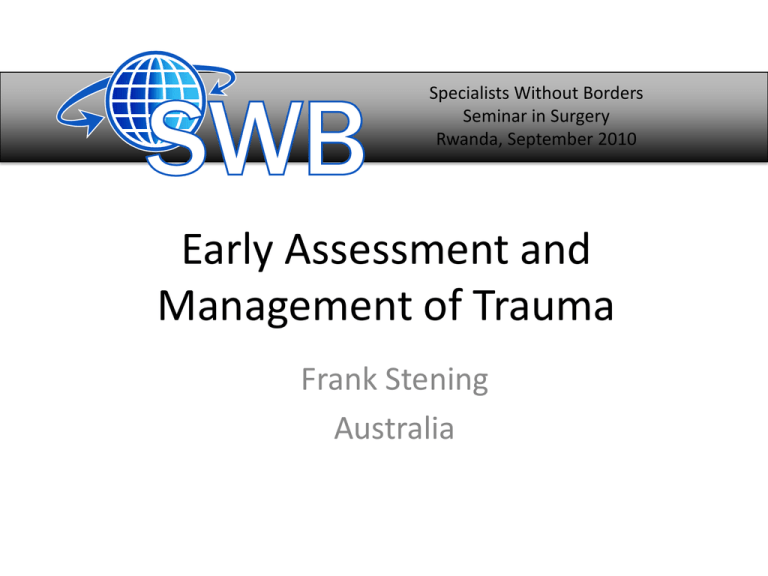
Specialists Without Borders Seminar in Surgery Rwanda, September 2010 Early Assessment and Management of Trauma Frank Stening Australia Objectives • Identify management priorities • Understand concept of Primary and Secondary Survey • Institute appropriate resuscitation and monitoring within first 60-120 minutes • Recognize the value of the patient’s history and mechanism of injury • Anticipate pitfalls KEY QUESTION How do we minimise MISSED injuries ? How do we improve survival rates ? ( Who needs transfer When do they need transfer ) Concepts of Initial Assessment • • • • • • • Rapid primary survey Resuscitation Adjuncts to primary survey/resuscitation Detailed secondary survey Adjuncts to secondary survey Re-evaluation Definitive care INITIAL MANAGEMENT AND ASSESSMENT 1. 2. 3. 4. 5. 6. 7. Preparation Triage Primary survey (ABC’s) Resuscitation Secondary survey (Head-to-toe) Continued post resuscitation monitoring and re-evaluation Definitive care Initial Assessment Primary survey and resuscitation of vital functions are done simultaneously = a team approach Triage Sorting of patients according to: ABCDEs Available resources Multiple casualties Mass casualties A quick, simple way to assess the patient in 10 seconds Identify yourself Ask the patient his / her name Ask the patient what happened ... an appropriate response suggests: Patent airway Sufficient air reserve to permit speech Clear sensorium Now proceed to a rapid primarysurvey Primary Survey • Adults, paediatric, pregnant women Priorities are the same! A B C D E Airway with c-spine protection Breathing Circulation with haemorrhage control Disability Exposure / Environment EMST Special Groups to Consider • Children • Elderly • Pregnant women Primary Survey Establish Patent Airway Beware C-spine injury Pitfalls Caution Equipment failure Inability to intubate Occult airway injury Progressive loss of airway Primary Survey Breathing • Oxygenate • Assess • Ventilate Caution Pitfalls Airway vs ventilation problem? Iatrogenic pneumothorax/ tension pneumothorax Primary Survey Assessment of Organ Perfusion Level of consciousness Skin colour and temperature Pulse rate and character Primary Survey Circulatory Management • Control haemorrhage • Restore volume • Reassess Caution Pitfalls Elderly Children Athletes Medications Primary Survey Disability • Baseline neurologic evaluation – GCS scoring – Pupillary response Caution Observe for neurologic deterioration Primary Survey Exposure / Environment • Completely undress the patient Caution Prevent hypothermia Adjuncts to Primary Survey Vital signs ECG Urinary output ABGs Adjuncts Urinary/gastric catheters unless contraindicated Pulse oximeter and CO2 PRIORITY PLAN X-RAYS (should be used judiciously and should not delay resuscitation) Lateral cervical spine AP chest AP pelvis Adjuncts to Primary Survey Diagnostic Tools • Chest and pelvic x-rays • DPL • Ultrasound Secondary Survey What is secondary survey? – Available history and head-to-toe examination When do I start? – After primary survey complete – After ABCDE’s re-assessed – Vital functions are returning to normal Secondary Survey Key Components • • • • • • History Physical examination: Head-to-toe “Tubes and fingers in every orifice” Complete neuro exam Special diagnostic tests Re-evaluation Secondary Survey History A Allergies M Medications P Past illnesses L Last meal E Events / Environment Secondary Survey Mechanisms of Injury Secondary Survey Head Complete neurologic exam GCS score determination Comprehensive eye exam Pitfalls – Unconscious patient – Periorbitaloedema – Occluded auditory canal Secondary Survey Maxillofacial • • Bony crepitus/stability Palpable deformity Pitfalls – Potential airway obstruction – Cribriformplate fracture – Frequently missed injury Secondary Survey Cervical Spine • • • • Palpate for tenderness Complete motor/sensory exams Reflexes C-spine imaging Pitfalls – – Altered LOC for any reason Other severe, painful injury Secondary Survey Neck (Soft tissues) • Mechanism: Blunt vs Pitfalls Delayed penetrating symptoms/signs • Symptoms: Airway Progressive obstruction, airway hoarseness obstruction • Findings: Crepitus, Occult injuries haematoma, stridor, bruit Secondary Survey Chest • • • • • Inspect Palpate Auscultation Percussion X-rays Pitfalls Elderly Children Secondary Survey Abdomen • Inspect, auscultate, palpate, and percuss • Re-evaluate frequently • Special studies Pitfalls – Hollow viscus and retroperitoneal injuries – Excessive pelvic manipulation Secondary Survey PerineumContusions, haematomas, lacerations, urethral blood RectumSphincter tone, high-riding prostate, pelvic fracture, rectal wall integrity, blood VaginaBlood, lacerations PitfallsUrethral injury in women, pregnancy Secondary Survey Musculoskeletal: Extremities • • • • • Contusion, deformity Pain Perfusion Peripheral neurovascular status X-rays as needed Secondary Survey Musculoskeletal: Pelvis • Pain on palpation • Symphysiswidth • Leg length uneven • X-rays as needed Secondary Survey Musculoskeletal Pitfalls – Potential blood loss – Missed fractures – Soft-tissue or ligamentous injury – Occult compartment syndrome (especially with altered LOC/hypotension) Secondary Survey NEUROLOGIC Spine / Cord • • • Complete motor and sensory exam Imaging as indicated Reflexes Secondary Survey Neurologic Pitfalls – – – Incomplete immobilisation Subtle in ICP with manipulation Rapid deterioration Re-evaluation Minimising Missed Injuries • • High index of suspicion Frequent re-evaluation and monitoring Re-evaluation Pain Management Relief of pain/anxiety as appropriate Administer intravenously Careful monitoring is essential PRIORITY PLAN DEFINITIVE CARE After identifying the patients injuries, managing life threatening problems and obtaining special studies SUMMARY 1. Primary survey 2. Resuscitation Adjuncts 3. Secondary survey 4. Definitive care
